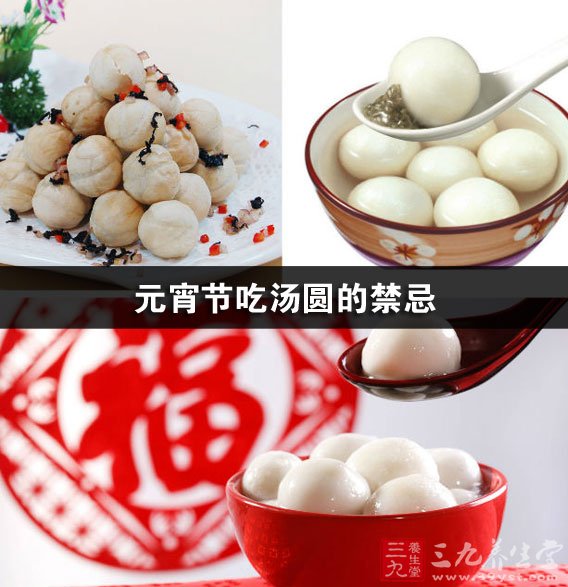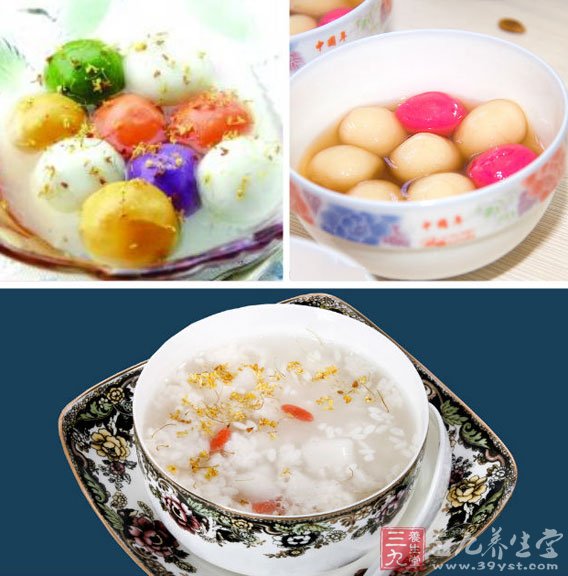来源:中华养生网
3月5日,正月十五是元宵节,除了大众知道的汤圆外,元宵节还有其他食俗。如果你对正月十五吃什么这个问题很好奇,不妨来了解元宵节必吃的食物吧!
1、汤圆
元宵节,南方人吃汤圆,主要祈求全家团团圆圆。做汤圆所用的糯米性平、味甘、补虚调血、健脾开胃、益气止泻,有暖中、生津和润燥的功能。再者各类汤圆常规馅主要以果料和干果为主,包括芝麻、核桃、花生,再加上植物油,营养价值就“更上层楼”。水煮汤圆是最简单的做法,其实也是最健康的吃法。
2、元宵
元宵节,北方人要吃元宵。说到元宵,不少人以为汤圆就是元宵。其实元宵和汤圆尽管在原料、外形上差别不大,实际是两种东西。最本质的区别在于制作工艺上。做汤圆相对简单,一般是先将糯米粉用水调和成皮,然后将馅“包”好即成。而元宵在制作上要繁琐得多:首先需将面和好,把凝固的馅切成小块,过一遍水后,再扔进盛满糯米面的笸箩内滚,一边滚一边洒水,直到馅料沾满糯米面滚成圆球方才大功告成。
3、生菜
广东人过元宵节时喜欢“偷”摘生菜,拌以糕饼煮食,据说这种食品代表吉祥。广东人的性格平和实在,对节庆也最图一个好意头,平时最常用于新店开业等节庆场合的生菜,也是元宵节必备的节庆用品。经常成为南方饭桌上常见蔬菜的生菜,名字就和“生财”谐音,因此也被看做是象征富贵吉祥的喜庆之物。
4、元宵茶
在陕西等地有吃元宵茶的风俗,就是在热汤面中放进各种菜和水果,很像古时的“元宵粥”。此茶增加了纤维素、矿物质及维生素的摄取,且不像普通元宵那么油腻,对于由于节日多食动物性食品而呈现的酸性体质有中和作用,也使元宵的营养更为全面。
5、油茶
元宵节夜晚的吃食,平地曰“十五扁,十六圆”,一天吃饺子,一天吃元宵;山区则是“十五打油茶,十六捏扁食”。正是所谓的“十里不同俗”。打茶是用筷子搅着茶面下锅做油茶也曰面茶。
6、油锤
元宵节的应节食品,在南北朝时浇上肉汁的米粥或豆粥。但这项食品主要用来祭祀,还谈不上是节日食品。到了唐朝郑望之的《膳夫录》才记载了:“汴中节食,上元油锤。”油锤的制法,据《太平广记》引《卢氏杂说》中一则《尚食令》的记载,类似后代的炸元宵。也有人美其名为“油画明珠”。
7、饺子
正月十五到了,北方有吃饺子的习惯,河南人有“十五扁、十六圆”的元宵节习俗、传统,所以正月十五应该吃饺子。饺子是一种历史悠久的民间吃食,深受老百姓的欢迎,民间有“好吃不过饺子”的俗语。
8、枣糕
豫西一带的人过元宵节喜欢吃枣糕,带有吉祥如意的寓意。枣糕原是清朝宫廷御用糕点,其味香远,入口丝甜,含有维生素C、蛋白质、钙、铁、维生素等营养成分,既能补脾和胃、益气生津;还有保护肝脏、增加肌力、养颜防衰之功效。
9、粘糕
粘糕又名年糕。元宵节除元宵、面条外,还有吃粘糕的。唐代名医孙思邈的《备急千金要方·食治》载牶“自梁米,昧甘、微寒、无毒、除热、益气。”唐代之后,元代也有元宵节食糕的记载。
10、面灯
说起元宵节的习俗,大家一般都会想到吃汤圆、赏花灯、猜灯谜,然而还有一种习俗是从汉朝就流传下来的,那就是正月十五点豆面灯。元宵节的灯光是吉祥之光,能驱妖辟邪祛病,因此正月十五捏豆面灯就是老百姓祈求新一年阖家幸福,家业兴旺。
11、豆面团
昆明人喜欢吃豆面团,做法跟元宵差不多,是将豆炒熟后磨面,团成丸子后用水煮熟即可,口感不错。
12、糟羹
台州一带每年正月十四看过花灯之后食糟羹。糟羹用肉丝、冬笋丝、香菇、木耳、鲜蜻、豆干、油泡、川豆板、菠菜等炒熟,再加入少许米粉,煮成带咸味的糊状食品。正月十五喝的糟羹为甜的,用番薯粉或藕粉配上莲子、甜枣、桂圆等做成。
13、馒头、麦饼
浙江浦江一带在元宵节有吃馒头、麦饼的习俗。据说原因是馒头为发面,麦饼为圆形,取“发子发孙大团圆”之意。湖南省常德上元各家以椒为汤,加入韭菜儆果诸物款待客人,称为“时汤”。
14、面条
江北地区民间流传有“上灯元宵,落灯面,吃了以后望明年”的民谚,当地人在正月十五晚上要吃面条,听起来与元宵不相关,但也有祈求吉利之意。《仪徽岁时记》载:“(正月)十八落灯,人家啖面,俗谓‘上灯圆子落灯面’,各家自为宴志庆。”落灯时吃面条寓意喜庆绵绵不断之意。
元宵节吃汤圆的禁忌 来源:三九养生堂
汤圆不宜当做早点

在元宵节很多家庭的汤圆都有多,想着可以留到第二天早上做早餐。但是汤圆里含量最多的是碳水化合物和脂肪,而蛋白质、矿物质、膳食纤维等非常少。这样的早餐,根本不能满足人们一上午的营养需求。
午后吃汤圆最好
吃汤圆最好的时间是在中午,这个时候人体的胃肠功能最强,也有充分的时间来消化汤圆里过多的热量。很多糖尿病人对无糖汤圆感兴趣,觉得没有糖就可以放心吃了。其实,无糖并不意味着低热量,也不意味着低血糖反应。因为汤圆中的糯米粉可使血糖升高,甚至比蜂蜜还要快,与白糖相差无几。哪怕没有加糖,吃它也一样不利于控制血糖,所以糖尿病人要十分小心。而且,里面没有糖不等于少放油,那么多的饱和脂肪酸,甚至还有反式脂肪酸,也不利于控制血脂。即使是在元宵佳节,吃汤圆也就两三个意思一下即可。
煮汤圆要讲究配汤

甜馅汤圆本身已有甜味,所以汤不需要再加糖,以减少热量摄取;若是无馅小汤圆,汤可以用桂圆红枣汤或桂圆姜汤取代,可有补身祛寒的功效;无馅料小汤圆还可以用花茶来煮,味道更新鲜,也可使用红糖及姜片煮汤圆以去除寒气,或放入桂圆、红枣、白木耳等,增加营养含量;煮咸汤圆时可放一些蔬菜,增加纤维素
吃汤圆要喝汤

经水煮,元宵中的不少营养成分如微量元素、营养素就溶在汤里。因此吃汤圆不能忘喝汤。喝汤可以促进消化吸收,即民间常说的“原汤化原食”。
The 15th day of the 1st lunar month is the Chinese Lantern Festival because the first lunar month is called yuan-month and in the ancient times people called night Xiao. The 15th day is the first night to see a full moon. So the day is also called Yuan Xiao Festival in China.
According to the Chinese tradition, at the very beginning of a new year, when there is a bright full moon hanging in the sky, there should be thousands of colorful lanterns hung out for people to appreciate. At this time, people will try to solve the puzzles on the lanterns and eat yuanxiao (glutinous rice ball) and get all their families united in the joyful atmosphere.
元宵节正月十五吃元宵的的习俗由来已久,元宵也叫“汤圆”、“圆子”。据说元宵象征合家团圆,吃元宵意味新的一年合家幸福、万事如意。
元宵节闹花灯的习俗起源于道教的“三元说”;正月十五日为上元节,七月十五日为中元节,十月十五日为下元节。主管上、中、下三元的分别为天、地、人三官,天官喜乐,故上元节要燃灯。元宵节的节期与节俗活动,是随历史的发展而延长、扩展的。就节期长短而言,汉代才一天,到唐代已为三天,宋代则长达五天,明代更是自初八点灯,一直到正月十七的夜里才落灯,整整十天。与春节相接,白昼为市,热闹非凡,夜间燃灯,蔚为壮观。特别是那精巧、多彩的灯火,更使其成为春节期间娱乐活动的高潮。至清代,又增加了舞龙、舞狮、跑旱船、踩高跷、扭秧歌等“百戏”内容,只是节期缩短为四到五天。
History
Until the Sui Dynasty in the sixth century, Emperor Yangdi invited envoys from other countries to China to see the colorful lighted lanterns and enjoy the gala(节日的,庆祝的)performances.
By the beginning of the Tang Dynasty in the seventh century, the lantern displays would last three days. The emperor also lifted the curfew(宵禁令), allowing the people to enjoy the festive lanterns day and night. It is not difficult to find Chinese poems which describe this happy scene.
In the Song Dynasty, the festival was celebrated for five days and the activities began to spread to many of the big cities in China. Colorful glass and even jade were used to make lanterns, with figures from folk tales painted on the lanterns.
However, the largest Lantern Festival celebration took place in the early part of the 15th century. The festivities continued for ten days. Emperor Chengzu had the downtown area set aside as a center for displaying the lanterns. Even today, there is a place in Beijing called Dengshikou. In Chinese, Deng means lantern and Shi is market. The area became a market where lanterns were sold during the day. In the evening, the local people would go there to see the beautiful lighted lanterns on display.
Today, the displaying of lanterns is still a big event on the 15th day of the first lunar month throughout China. People enjoy the brightly lit night. Chengdu in Southwest China's Sichuan Province, for example, holds a lantern fair each year in the Cultural Park. During the Lantern Festival, the park is literally an ocean of lanterns! Many new designs attract countless visitors. The most eye-catching lantern is the Dragon Pole. This is a lantern in the shape of a golden dragon, spiraling up a 27-meter -high pole, spewing fireworks from its mouth. It is quite an impressive sight!
元宵节是中国的传统节日,早在2000多年前的西汉就有了,元宵赏灯始于东汉明帝时期,明帝提倡佛教,听说佛教有正月十五日僧人观佛舍利,点灯敬佛的做法,就命令这一天夜晚在皇宫和寺庙里点灯敬佛,令士族庶民都挂灯。以后这种佛教礼仪节日逐渐形成民间盛大的节日。该节经历了由宫廷到民间,由中原到全国的发展过程。
在汉文帝时,已下令将正月十五定为元宵节。汉武帝时,“太一神”的祭祀活动定在正月十五。(太一:主宰宇宙一切之神)。司马迁创建“太初历”时,就已将元宵节确定为重大节日。
另有一说是元宵燃灯的习俗起源于道教的“三元说”;正月十五日为上元节,七月十五日为中元节,十月十五日为下元节。主管上、中、下三元的分别为天、地、人三官,天官喜乐,故上元节要燃灯。
元宵节的节期与节俗活动,是随历史的发展而延长、扩展的。就节期长短而言,汉代才一天,到唐代已为三天,宋代则长达五天,明代更是自初八点灯,一直到正月十七的夜里才落灯,整整十天。与春节相接,白昼为市,热闹非凡,夜间燃灯,蔚为壮观。特别是那精巧、多彩的灯火,更使其成为春节期间娱乐活动的高潮。至清代,又增加了舞龙、舞狮、跑旱船、踩高跷、扭秧歌等“百戏”内容,只是节期缩短为四到五天。
Origin
There are many different beliefs about the origin of the Lantern Festival. But one thing for sure is that it had something to do with religious worship.
One legend tells us that it was a time to worship Taiyi, the God of Heaven in ancient times. The belief was that the God of Heaven controlled the destiny of the human world. He had sixteen dragons at his beck and call and he decided when to inflict drought, storms, famine or pestilence(瘟疫)upon human beings. Beginning with Qinshihuang, the first emperor to unite the country, all subsequent emperors ordered splendid ceremonies each year. The emperor would ask Taiyi to bring favorable weather and good health to him and his people. Emperor Wudi of the Han Dynasty directed special attention to this event. In 104 BC, he proclaimed it one of the most important celebrations and the ceremony would last throughout the night.
Another legend associates the Lantern Festival with Taoism. Tianguan is the Taoist god responsible for good fortune. His birthday falls on the 15th day of the first lunar month. It is said that Tianguan likes all types of entertainment. So followers prepare various kinds of activities during which they pray for good fortune.
The third story about the origin of the festival is like this. Buddhism first entered China during the reign of Emperor Mingdi of the Eastern Han Dynasty. That was in the first century. However, it did not exert any great influence among the Chinese people. one day, Emperor Mingdi had a dream about a gold man in his palace. At the very moment when he was about to ask the mysterious figure who he was, the gold man suddenly rose to the sky and disappeared in the west. The next day, Emperor Mingdi sent a scholar to India on a pilgrimage(朝圣)to locate Buddhist scriptures. After journeying thousands of miles, the scholar finally returned with the scriptures. Emperor Mingdi ordered that a temple be built to house a statue of Buddha and serve as a repository for the scriptures. Followers believe that the power of Buddha can dispel darkness. So Emperor Mingdi ordered his subjects to display lighted lanterns during what was to become the Lantern Festival.
关于元宵节的来历,民间还有几种有趣的传说:
关于灯的传说
传说在很久以前,凶禽猛兽很多,四处伤害人和牲畜,人们就组织起来去打它们,有一只神鸟困为迷路而降落人间,却意外的被不知情的猎人给射死了。天帝知道后十分震怒,立即传旨,下令让天兵于正月十五日到人间放火,把人间的人畜财产通通烧死。天帝的女儿心地善良,不忍心看百姓无辜受难,就冒着生命的危险,偷偷驾着祥云来到人间,把这个消息告诉了人们。众人听说了这个消息,有如头上响了一个焦雷。吓得不知如何是好,过了好久,才有个老人家想出个法子,他说:“在正月十四、十五、十六日这三天,每户人家都在家里张灯结彩、点响爆竹、燃放烟火。这样一来,天帝就会以为人们都被烧死了”。
大家听了都点头称是,便分头准备去了。到了正月十五这天晚上,天帝往下一看,发觉人间一片红光,响声震天,连续三个夜晚都是如此,以为是大火燃烧的火焰,以中大快。人们就这样保住了自己的生命及财产。为了纪念这次成功,从此每到正月十五,家家户户都悬挂灯笼,放烟火来纪念这个日子。
Yuanxiao
Besides entertainment and beautiful lanterns, another important part of the Lantern Festival,or Yuanxiao Festival is eating small dumpling balls made of glutinous rice flour. We call these balls Yuanxiao or Tangyuan. Obviously, they get the name from the festival itself. It is said that the custom of eating Yuanxiao originated during the Eastern Jin Dynasty in the fourth centuty, then became popular during the Tang and Song periods.
The fillings inside the dumplings or Yuansiao are either sweet or salty. Sweet fillings are made of sugar, Walnuts(胡桃), sesame, osmanthus flowers(桂花), rose petals, sweetened tangerine peel, bean paste, or jujube paste(枣泥). A single ingredient or any combination can be used as the filling . The salty variety is filled with minced meat, vegetables or a mixture.
The way to make Yuanxiao also varies between northern and southern China. The usual method followed in southern provinces is to shape the dough of rice flour into balls, make a hole, insert the filling, then close the hole and smooth out the dumpling by rolling it between your hands. In North China, sweet or nonmeat stuffing is the usual ingredient. The fillings are pressed into hardened cores, dipped lightly in water and rolled in a flat basket containing dry glutinous rice flour. A layer of the flour sticks to the filling, which is then again dipped in water and rolled a second time in the rice flour. And so it goes, like rolling a snowball, until the dumpling is the desired size.
The custom of eating Yuanxiao dumplings remains. This tradition encourages both old and new stores to promote their Yuanxiao products. They all try their best to improve the taste and quality of the dumplings to attract more customers.
汉文帝时为纪念“平吕”而设
另一个传说是元宵节是汉文帝时为纪念“平吕”而设。汉高祖刘邦死后,吕后之子刘盈登基为汉惠帝。惠帝生性懦弱,优柔寡断,大权渐渐落再吕后手中。汉惠帝病死后吕后独揽朝政把刘氏天下变成了吕氏天下,朝中老臣,刘氏宗室深感愤慨,但都惧怕吕后残暴而敢怒不敢言。
吕后病死后,诸吕惶惶不安害怕遭到伤害和排挤。于是,在上将军吕禄家中秘密集合,共谋作乱之事,以便彻底夺取刘氏江山。
此事传至刘氏宗室齐王刘囊耳中,刘囊为保刘氏江山,决定起兵讨伐诸吕随后与开国老臣周勃,陈平取得联系,设计解除了吕禄,“诸吕之乱”终于被彻底平定。
平乱之后,众臣拥立刘邦的第二个儿子刘恒登基,称汉文帝。文帝深感太平盛世来之不易,便把平息“诸吕之乱”的正月十五,定为与民同乐日,京城里家家张灯结彩,以示庆祝。从此,正月十五便成了一个普天同庆的民间节日——“闹元宵”。
元宵节英语(论坛)词汇
元宵节:festival of lanterns,lantern festival dumplings
元宵: the rice glue ball
灯谜:riddles written on lanterns
灯具:lamps and lanterns
灯花 snuff
灯笼裤 bloomers galligaskins knickers pantalettes plus fours
灯笼 lantern scaldfish
灯塔 beacon lighthouse pharos
灯语 lamp signal
灯油 kerosene lamp oil
灯心蜻蜓 damselfly









